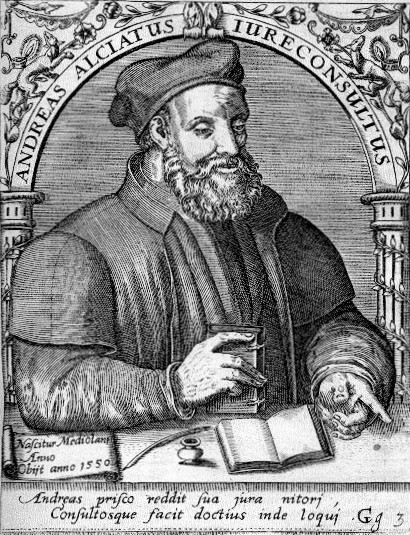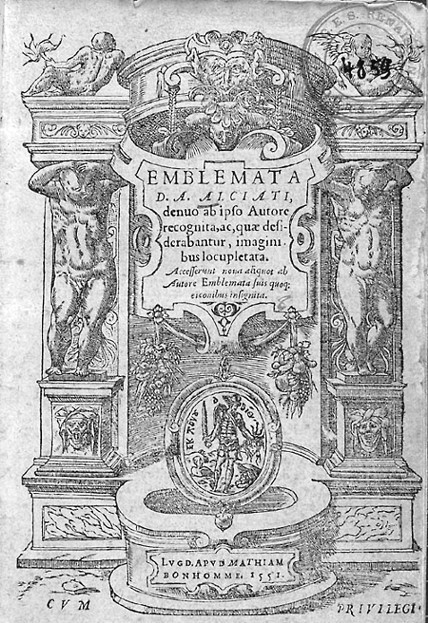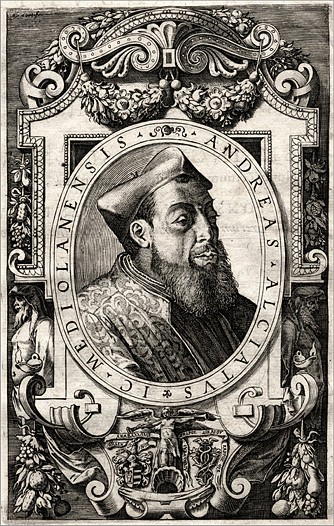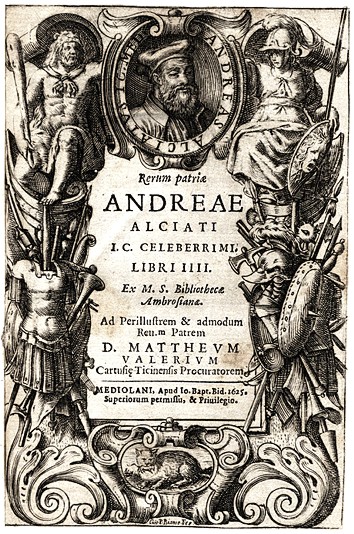Lessico
Andrea Alciato / Alciati

Incisione di Theodor de Bry
(1528-1598)
da Bibliotheca chalcographica di Jean-Jacques Boissard - 1669
Giurista e
umanista (Alzate Brianza (CO) 1492 - Pavia 1550). Compì i suoi studi nello Studio di
Bologna. Da Milano, dove per quattro anni esercitò l'avvocatura, si recò in
Francia come insegnante di diritto civile ad Avignone e a Bourges, onorato
della stima di Francesco I![]() .
Da Paolo III fu nominato protonotario apostolico. Nelle sue opere giuridiche
(monografie di diritto canonico e commentari al Digesto) armonizzò la
tradizione degli studi giuridici italiani con il movimento umanistico del suo
tempo. In campo letterario è noto per i suoi Emblemata (1531),
raccolta di allegorie morali, illustrate.
.
Da Paolo III fu nominato protonotario apostolico. Nelle sue opere giuridiche
(monografie di diritto canonico e commentari al Digesto) armonizzò la
tradizione degli studi giuridici italiani con il movimento umanistico del suo
tempo. In campo letterario è noto per i suoi Emblemata (1531),
raccolta di allegorie morali, illustrate.

Claude Mignault relates to us in his Vita Alciati that the jurist Andrea Alciato was born in Alciata or Alzata, near Lake Como, the only son of the Milan merchant Ambrogio Alciato. His studies from 1504 with Aulus Janus Parrhasius in Milan, as well as the lectures of Janus Lascaris, provided him with a firm background in Classical philology, as is reflected in his Humanistic analysis of jurisprudence. But his first writings also reflect his other interests: a collection of ancient inscriptions, a treatise about the modern use of ancient coins, and studies on the churches and history of Milan.
In 1507 he began his studies in law in Pavia, and in 1511 he went to Bologna. Soon, in 1516, he published in Strasbourg his first works of jurisprudence, and received his doctoral grade in Ferrara. Returning to Milan, he combined his juridical practice with his never-abandoned Classical studies. A testimony to this is given by his notes to the works of Tacitus, published by Alessandro Minuziano in 1517. This same printer edited some of his other works on jurisprudence in the following five years. With these Alciato entered in the élite of the new European jurisprudence, in the company of Guillaume Budé or Udalricus Zasius.
In 1518 he was invited to lecture in Avignon, where he resided until 1522, with intermittent absences caused by plague. Here in 1520 he met Bonifacius Amerbach, who became an intermediary between him and Erasmus. In 1521 he received from Pope Leo X the honorific title of count palatine.
Between 1522 and 1527 Alciato lived in Milan, devoting himself to private studies: translations from the Greek Anthology and of Aristophanes, and the composition of his Emblemata. In these years of war his city was invaded both by French (1523) and by Spanish (1526). In 1529 Francis I invited him to lecture at Bourges, where he remained until 1533. His lectures were attended by a lot of admirers from all over Europe, including the king himself. In 1530 his two most important works, the De verborum significatione, and Commentarii ad rescripta principum, were published in Lyons.
He was appointed member of the Senate of Milan, and from 1533 to 1537 he lived in Pavia. The outbreak of a new war constrained him to move to Bologna. Here he lived until 1542, when Ercole d'Este invited him to Ferrara. In 1546 he declined the cardinalship offered by Paul III, accepting only the title of apostolic protonotary. In the same year he was called back to Pavia, where he taught until his death in 1550. His funeral monument, erected in the Church of the Epiphany in Milan, was transferred in 1773 to the University of Pavia, where it is conserved until today.

The Emblematum liber - The best-known and most influential work of Alciato was conceived as a mere collection of Greek epigrams translated into Latin. The 30 epigrams first published in the Selecta epigrammata graeca (Basel 1529) are the core of the Emblematum liber. These, and a number of other ones, provided with sententious phrases as titles, constitute that collection of 105 epigrams that Alciato donated to his friend Conrad Peutinger, and which were published in 1531 at Steiner in Augsburg, apparently without the knowledge of the author. The editor gave the title Emblematum liber to the collection, and decided on his own to illustrate each composition with a small engraving, thus creating that triple structure – motto, engraving, epigram – that from that time on is known as "emblem".
The immediate success of the book convinced Alciato to publish it, in a more carefully edited form and with better engravings. Thus the Paris editor Christian Wechel published a second edition in 1534, which already contained 113 emblems; and in 1542 a third one with two more emblems. This same editor was to publish the first translations as well, in 1536 in French, and in 1542 in German.
When Aldus in 1546 published in Venice a collection of 84 additional emblems, the book took a great step nearer to its definitive constitution. This was followed by the collaboration of Alciato with the bookseller Guillaume Rouillé and the printer Macé Bonhomme of Lyons. The Lyons enterprise published a series of editions and translations – in Spanish, French and Italian – with new engravings, commissioned to Pierre Eskreich. In 1548 the book already included 201 emblems (although only 128 illustrated ones). This edition was already organized according to the thematic order conceived by Barthélemy Aneau. The 1549 Spanish translation introduced ten new emblems. Finally in 1550, in the year of the death of Alciato, there was published the Lyons edition that can be regarded as definitive. This one contains all the emblems composed by him, all illustrated, 211 in all (one fewer than there should be, due to having eliminated the controversial Emblem 80 "Adversus naturam peccantes").
With the death of Alciato there began the series of reimpressions and commentaries. The complete series is reproduced in the CD by Studiolum that follows through the editorial success of this work.
And all that began with that small booklet of 1531 that is now offered to our readers in our open library.
www.studiolum.com
